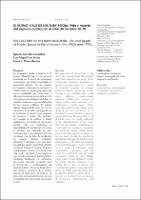Por favor, use este identificador para citar o enlazar este ítem:
https://repositorio.usj.es/handle/123456789/567
Registro completo de metadatos
| Campo DC | Valor | Lengua/Idioma |
|---|---|---|
| dc.contributor.author | Grávalos Lacambra, Ignacio | - |
| dc.contributor.author | Lus Arana, Luis Miguel | - |
| dc.contributor.author | Perez Moreno, Lucia Carmen | - |
| dc.date.accessioned | 2021-06-22T11:01:48Z | - |
| dc.date.available | 2021-06-22T11:01:48Z | - |
| dc.date.issued | 2018-02 | - |
| dc.identifier.citation | Gravalos Lacambra, Ignacio, Luis Miguel Lus Arana, y Lucía C. Pérez-Moreno. 2018. «El último Viaje De Los Baby Boom. Vida Y Muerte Del Espacio Público En El Cine De Los años 60-70.». BAc Boletín Académico. Revista De investigación Y Arquitectura contemporánea 8 (noviembre). A Coruña:25-44. https://doi.org/10.17979/bac.2018.8.0.3157. | es_ES |
| dc.identifier.issn | 2173-6723 | es_ES |
| dc.identifier.uri | https://repositorio.usj.es/handle/123456789/567 | - |
| dc.description | The generation of those born at the end of the Second World War reached their youth carried by the inertia of the technocratic optimism developed by the previous generation. In a context of economic bonanza, the younger generation rebelled against the system, creating a new sensibility that would spawn different countercultural responses. Within these attempts to change society, cities witnessed a re-codification of public spaces. Urban space, discredited by the echoes of the "death of the street" promoted by Le Corbusier, was reactivated as a stage for protest and action. However, this revival of public space was rapidly suffocated by the disenchantment of the youth. Once the impossibility to transform the system had been confirmed, a search for new territories started, which cinema interpreted following two strategies: on the one hand, through the production of definitely inhospitable and devastated urban spaces; on the other, by retreating to the individual sphere, which reflected on new modes of habitation. Small communities, communes, and the return to a controlled rural life would be responses which, far from building public realm, would ultimately provide the system with the argument it was looking for in order to destroy and reconfigure the public domain. The films of the late 1960s and early 1970s show the ultimate defeat of a desire which, in the end, was attached to an iconography of destruction, abandonment, and emptiness. | es_ES |
| dc.description.abstract | La generación nacida al final de la II Guerra Mundial llegó a su juventud arrastrada por la inercia del optimismo tecnocrático que había desarrollado la generación anterior. En un contexto de bonanza económica, la juventud se rebeló contra el sistema generando una nueva sensibilidad que daría lugar a diferentes respuestas contraculturales. En estos intentos de cambiar la sociedad, las ciudades asistieron a una recodificación de los espacios públicos. El espacio urbano, desacreditado bajo los ecos de “la muerte de la calle” promulgada por Le Corbusier, se reactivó como escenario de protesta y acción. Sin embargo, este resurgir de lo público se diluyó rápidamente al compás del desencanto juvenil. Una vez confirmada la imposibilidad de transformar el sistema, se produjo una búsqueda de otros territorios que el cine interpretó bajo dos estrategias: por un lado, la producción de espacios urbanos totalmente inhóspitos y desolados; por otro lado, un repliegue hacia lo individual reflejado en nuevas formas de habitar. Pequeñas comunidades, comunas y la vuelta a una vida rural controlada serán respuestas que, lejos de construir un ámbito público, resultarán finalmente el argumento que estaba buscando el sistema para la destrucción y reconfiguración del dominio público. El cine de finales de los años sesenta y principios de los setenta muestra el desencanto del final de un deseo que acaba identificándose con una iconografía de la destrucción, desamparo y vacío. | es_ES |
| dc.format.mimetype | application/pdf | es_ES |
| dc.language.iso | spa | es_ES |
| dc.language.iso | eng | es_ES |
| dc.publisher | UNIV CORUNA, SERVICIO PUBLICACIONS | es_ES |
| dc.rights | Atribución 4.0 Internacional | * |
| dc.rights.uri | http://creativecommons.org/licenses/by/4.0/ | * |
| dc.subject | Contracultura | es_ES |
| dc.subject | Imaginario urbano | es_ES |
| dc.subject | Conografía del vacío | es_ES |
| dc.subject | Imaginería del desastre | es_ES |
| dc.subject | Counterculture | es_ES |
| dc.subject | Urban imagery | es_ES |
| dc.subject | Iconography of emptiness | es_ES |
| dc.subject | Imagination of disaster | es_ES |
| dc.title | El último viaje de los Baby Boom. Vida y muerte del espacio público en el cine de los años 60-70 | es_ES |
| dc.title.alternative | The last trip of the Baby Boomers. Life and Death of Public Space in the cinema in the 1960s and 1970s. | es_ES |
| dc.type | journal article | es_ES |
| dc.subject.unesco | Contracultura | es_ES |
| dc.relation.publisherversion | https://revistas.udc.es/index.php/BAC/article/view/bac.2018.8.0.3157 | es_ES |
| dc.identifier.publicationfirstpage | 25 | es_ES |
| dc.identifier.publicationlastpage | 44 | es_ES |
| dc.identifier.doi | 10.17979/bac.2018.8.0.3157 | es_ES |
| dc.rights.accessRights | open access | es_ES |
| Aparece en las colecciones: | Artículos de revistas | |
Ficheros en este ítem:
| Fichero | Descripción | Tamaño | Formato | |
|---|---|---|---|---|
| EL ÚLTIMO VIAJE DE LOS BABY BOOM.pdf | 10,47 MB | Adobe PDF |  Visualizar/Abrir |
Este ítem está sujeto a una licencia Creative Commons Licencia Creative Commons

